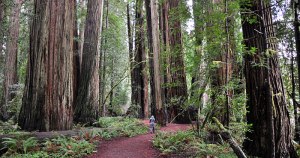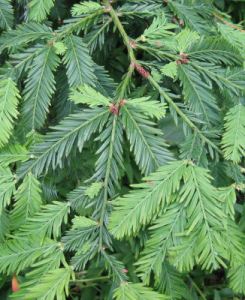 Tallest-in-the-world trees. They only live in a narrow ribbon along the California coast from the Oregon border to the coastline south of Big Sur, no more than 50-miles inland. Trees that are 2000+ years old were saplings when the Roman and Aztec empires flourished. Embraced by giants, the redwood forest defines our home.
Tallest-in-the-world trees. They only live in a narrow ribbon along the California coast from the Oregon border to the coastline south of Big Sur, no more than 50-miles inland. Trees that are 2000+ years old were saplings when the Roman and Aztec empires flourished. Embraced by giants, the redwood forest defines our home.
Visits from out-of-state friends and relatives from abroad encourage appreciation of these trees’ unique features and the adaptations that has allowed their species to survive since the Jurassic period, over 200 million years ago.
Redwood roots weave together to support the immense columns. Roots stretch as far as 150 feet away from the main trunk to neighboring trees. Friendly horizontal mingling gives each greater strength. The root systems are not deeper than 12 feet into the Earth; these shallow roots can collect essential nutrients and water closer to the soil surface.
Redwoods are burly in several ways. “Burls” are knobby growths that produce new shoots. Trees grow out of the same base, and when the center tree dies, a circle of trees mark its place (affectionately called a fairy ring or a redwood cathedral). Disturbance initiates burl growth on high branches; storm damage encourages a new shoot to sprout and grow parallel to the main trunk. Branches fuse into other branches creating loops, “reiterated trunks” and unique patterns in the canopy.
 Redwood leaves are adapted to height. On the top branches, overlapping leaves are “scale-like”. The treetops get lots of light so the leaves do not need to be flat. The smaller leaves protect against water loss from evaporation and drying wind. In the bottom two-thirds of the trees, leaves look like long, flattened teardrops. Fog condenses on these leaves and drips from pointed tips into the soil providing important moisture in the dry, summer months.
Redwood leaves are adapted to height. On the top branches, overlapping leaves are “scale-like”. The treetops get lots of light so the leaves do not need to be flat. The smaller leaves protect against water loss from evaporation and drying wind. In the bottom two-thirds of the trees, leaves look like long, flattened teardrops. Fog condenses on these leaves and drips from pointed tips into the soil providing important moisture in the dry, summer months.
Different cones grow on different parts of the tree. Male cones, small as pinto beans, grow on branchlet tips in the lower half of redwoods and release pollen on dry winter days. Wind transports powdery pollen to female seed cones located on upper tree branches. Female seed cones – the size of green olives – hold 30-60 tiny seeds. One tree can release ten million seeds in a year.
Each redwood is amazing in and of itself. The forests of these giants support species and systems unique only to our coastline. Now is the time to recognize how unique and precious they are. If you have not yet signed the petition for the Santa Cruz Redwood National Monument, please join the effort today at: santacruzredwoods.org

March 26, 2015 at 7:11 am
Truly majestic trees. Thanks for sharing… brought back some fond memories of Big Sur.
LikeLike